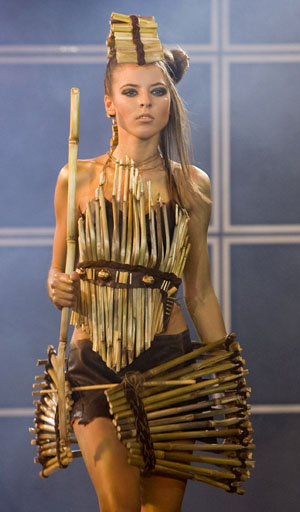Having read a lot of recent coverage of the FTC’s August 2009 ruling about bamboo, I wonder what will become of brands whose staple fabric is “bamboo”? The problem is, most of these designers and the textile sales reps they buy from, were sold rayon fabric labeled as bamboo. Rayon is a semi-synthetic fiber based on wood pulp. Sure, some of that wood pulp could be bamboo, but try getting a Chinese textile mill to tell you what they’re actually putting into the mix, as opposed to what they know you want them to tell you is in there.
While Viscose Rayon (known simply as Rayon in the US) is a wonderfully breathable fiber with great texture, strength, and drape-ability, it does require a lot of nasty chemicals to turn that wood pulp, bamboo or otherwise, into soft textile products. In Delia Montgomery’s recent article on the subject, one of the comments mentions the impact of cotton, complaining that cotton has a more negative net impact than bamboo.
Bamboo vs. Cotton vs. Polyester? Why Choose?
This is an important consideration, as cellulosic fibers (Rayon, Lyocell, and all other plant-based semi-synthetics) represent less than 3% of world fiber production, but cotton and polyester each represent close to 25% of the world’s fiber consumption, according to Kate Fletcher’s book, “Sustainable Fashion & Textiles.” Kate goes on to explain that Rayon (called Viscose outside of the US), is derived from raw materials which are carbon-neutral in that their growing cycle absorbs as much CO2 as their being harvested consumes. However, she continues by pointing out that the water effluent from Viscose production is extremely toxic. She recommends choosing Viscose from mills with strict effluent treatment protocols (not an easy task when these factories are almost entirely in China and clearly not concerned with effluent impacts) or even avoiding Viscose entirely in favor of Lyocell (brand name Tencel).
Earlier this month, we featured an in-depth look at the reasons why one eco-designer, Ecogear, has chosen to avoid the whole bamboo controversy and instead chooses the most environmentally responsible textile available- recycled. Patagonia pioneered recycled polyester made from PET plastic, and worked with Teijin to develop closed-loop garment recycling. Nike’s Lorrie Vogel is also deeply committed to improving access to recycled fibers, to move toward completely closed-loop textile products, whether their inputs come from plastic bottles or cotton sheets.
Bringing Bamboo Out of the Niche Market
All this fuss over what represents less than 3% of the world’s fibers? Well, as a big proponent of diversity, including ecological diversity, I think we rely entirely too much on cotton and polyester. The primary reason these two fibers represent 50% of the world’s fiber use is cost. Cotton is cheap because talented lobbyists have convinced the US government to spend billions of American tax dollars on subsidizing the most productive farmers, and really, the same goes for polyester, which comes from crude oil. Without these subsidies, other raw materials might be more competitive. This Oxfam article discusses the problem of the US’s illegal cotton subsidies.
The Impact on China’s Water Supply
 This photo from a textile mill in China is one of the subtler examples of how weak the treatment process can be. The water quality problem in China is grave, and our insatiable hunger for cheap stuff fuels the fire. The Institute of Public and Environmental Affairs is helping solve this problem by increasing transparency. Their website lists rankings of factories based on their water pollution, though I could not find reports for any textile manufacturers.
This photo from a textile mill in China is one of the subtler examples of how weak the treatment process can be. The water quality problem in China is grave, and our insatiable hunger for cheap stuff fuels the fire. The Institute of Public and Environmental Affairs is helping solve this problem by increasing transparency. Their website lists rankings of factories based on their water pollution, though I could not find reports for any textile manufacturers.
All materials require some energy and water to produce, as well as create some degree of air and water impacts. We can reduce our energy footprint by buying locally-made clothing, our water footprint by buying (ideally recycled) polyester clothing, and further advancements are always in the works for textiles that give us everything we want- style, comfort, durability, and zero impact, all at the unsustainably low prices we’ve come to expect. Ultimately, as consumers, we need to decide what’s more important- paying less money, or having a lower impact?
Photo of Bamboo Dress by Anna Ostrovskaya, Courtesy Reuters Oddly Enough
Photo of Chinese textile factory effluent courtesy Greenpeace India


